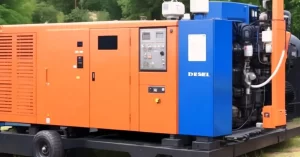Table of Contents
Best Knowledge On DG Set
“Welcome to our guide on the Best Knowledge On DG Sets. A DG or Diesel Generator Set is like a backup power hero. It’s there to save the day when the electricity goes out. The knowledge will rescue you in all emergencies.
We will explain step by step and will explain the importance of each step. Whether you’re a seasoned DG Set owner or just starting, we’ve got something for everyone.
Our guide will cover the basics of advanced techniques. You’ll learn to store your DG Set properly, keep it rust-free, and ensure it’s always ready to kick into action when needed.
So, keep reading if you want to be the hero in your power outage story and keep your DG Set in the best shape possible. Let’s dive into the Best Knowledge On DG Sets together!”



Short Description of DG sets
Diesel Generator Components
A DG set comprises important parts that must work together to function properly. These important parts are:
Prime Mover (Diesel Engine) and Associated Accessories: The heart of the DG set is the prime mover, typically a diesel engine, which provides the necessary mechanical energy to generate electricity.
Alternator (AC Generator): The alternator, also known as an AC generator, converts the mechanical energy from the prime mover into electrical energy.
Switchgear and Control System: Switchgear and control systems are essential for managing the flow of electricity, ensuring the safety of the DG set, and allowing for its smooth operation. Switches, control panels, and circuit breakers are some of them.
Powerhouse Design and Foundation Civil Work: The design of the powerhouse and the civil work for the foundation are critical aspects of DG set installation. Proper design and construction ensure the stability and durability of the generator’s installation.
Connected Load on Self-Components: The DG set’s performance is influenced by the connected load, which includes various electrical devices such as heaters, motor drives, lighting systems, and more. Knowing how much electrical power it needs to provide is important to ensure a DG set works well.
In short, for a DG set to work properly, all its parts must work together smoothly.
Estimating DG Set Rating: Formulas
When estimating the rating of a DG set, several formulas can be applied:
- DG Set Rating in KW:
- Formula: DG Set Rating in KW = Maximum Demand / % Loading
- Maximum Demand in KW:
- Formula: Maximum Demand In KW = Connected Load / Diversity Factor
- Rating in KVA:
- Formula: Rating in KVA = DG Set Rating in KW / Power Factor
- Diversity Factor:
- Formula: Diversity Factor = Installed Load / Running Load
These formulas are valuable tools for calculating and determining the appropriate rating for a DG set, considering factors like maximum demand, diversity, and power factor. Proper estimation ensures that the DG set can effectively meet the power requirements of the connected load.
Types of Cooling in DG sets
There are two primary types of cooling systems used in DG sets:
- Air Cooling: This method uses air circulation to dissipate heat and maintain proper engine temperatures.
- Water Cooling: Water-cooled DG sets are considered superior to air-cooled ones. In hot summer conditions, air cooling may struggle to keep the engine’s cooling water temperatures within acceptable limits, while water cooling is more effective in such scenarios.
Why Small DG Sets Shouldn’t Be Paralleled with the Grid Supply
Small DG sets should not be paralleled with the grid supply for several reasons. When connected to the grid, a small DG set faces risks related to safety and protection mechanisms.
- Reverse Power Relay: Grids operate as infinite buses with a constant power supply. Small DG sets may not provide sufficient power output to match the grid’s supply. Paralleling them could lead to reverse power flow, triggering reverse power relays. These relays are designed to prevent power from flowing back into the DG set, safeguarding its operation.
- Voltage and Frequency Relay: Grids maintain stable voltage and frequency levels. Small DG sets, especially if not synchronized precisely, may struggle to match these levels. Paralleling can result in voltage and frequency deviations, which can be detrimental to the DG set’s performance and reliability.
In summary, small DG sets are not ideal for paralleling with the grid supply due to the risk of encountering reverse power relay issues and potential voltage and frequency discrepancies. Proper synchronization and sizing considerations are crucial when integrating DG sets with the grid to ensure safe and efficient operation.
Unbalanced loads and its effect on DG set operation
A balanced load must always be maintained for DG set operation to run well. Unbalanced loads can cause a number of anomalies and problems that impact the linked electrical system and the generator.
Here’s a look at the consequences of unbalanced loads:
Increased Losses: Unbalanced loads cause uneven power distribution among the phases. As a result, losses within the DG set and the electrical system increase. These losses could be resistive losses, which increase heat production and decrease efficiency.
Excessive Heating: The uneven distribution of power due to unbalanced loads can lead to excessive system heating.
Decreased Efficiency: Efficiency is a critical factor in DG set operation. Unbalanced loads reduce the overall efficiency of the generator.
Unbalanced Output Voltage: Unbalanced loads can result in unbalanced output voltages. This can be detrimental to sensitive equipment and machinery connected to the generator. Voltage imbalances can lead to malfunctions and decreased performance in connected devices.
To ensure smooth and efficient DG set operation, it’s recommended to maintain balanced loads. The maximum permissible load variation between phases should not exceed 10% of the DG set’s capacity.
Effects of running DG set at a low power factor
Losses will increase due to the higher excitation current demand at a low power factor. Oversize AC generators running at lower power factors will result in poor operating efficiency and higher cost.
Energy balance in DG set.
Input
Thermal Energy; 100%
Output
Electrical Output; 35%
Alternator losses; 4%
Flue gases losses; 33%
Coolant losses; 24%
Radiation losses; 4%
Factor affecting waste heat recovery from flue gases
- Loading of DG set
- Exhaust gas temperature after the Turbocharger
- Operating hours
- Back pressure on DG set
Impact of Back pressure in the exhaust gas system
Additional pressure drop in the waste heat recovery unit causes back pressure in flue gas pathways. The back pressure should be between 250 to 300 mm of Wc.
Waste heat recovery methods from DG set flue gases
- Waste heat recovery Boiler ( WHRB)
- Hot water use in the vapor absorption system
Application of Waste heat recovery system of DG set
- Steam generation by WHRB
- Pre-heating of combustion air for heaters and furnaces.
- Air heating in dryers
- Process hot water generation
- Process thermal oil heating
- Use in vapor absorption refrigeration system
- Pre-heating of Stock furnaces
Special Instruments to carry out the energy audit of the DG set.
- Fyrite kit for the measurement of CO2 % in flue gases
- Optic Pyrometer with sensor
- Anemometer with vane for measuring the radiator air velocity
- Engine Speed measuring digital tachometer
- Load manager/ Power Analyser to measure the electrical parameters ( Voltage, current, KW, KVA, and Power factor)
Energy conservation methods for DG set
- Waste heat recovery from flue gases
- Load factor improvement
- Installation of a paralleling system for the improved loading and economical operation of DG sets
- Filtration improvement
DG set performance analyzing parameters.
- Average Engine loading
- Average Alternator loading
- Alternator loading percentage
- Engine loading percentage
- Specific power generation KWH/ litre.
Vital steps during the selection of DG set with non-linear loads
Application check for the following loads.
- Rectifier/ Thyristor loads
- Welding loads
- Furnace Loads
Take the consultation from the OEM of DG set for the proper recommendations on achievement of desired utilization of DG set without any problem.
Identify the loads sensitive to voltage, frequency regulation, and voltage waveform, and feed such loads by a dedicated power supply which usually assumes the form of a DG motor-driven generator set. This alternative will ensure the restriction of the design of the AC generator. This process will also restrict the overall cost of the DG set.
Consider the following points while selecting the engine for the Dg set.
- Engine Power
- Engine Speed.
Engine Power;- Maximum load is the decisive factor for the power requirement. Engine power rating should be 10 to 20% more than the power requirement demanded by the end-user. By choosing the extra rating will prevent the engine from getting overload.
Engine Speed’- Engine speed is the other important factor for the selection of an Engine. The engine will be more efficient at optimum speed. Operate The DG set at the rated speed to avoid unwanted deposits in the combustion chamber and exhaust manifold.
Diesel Power plant advantages(Best knowledge on | DG set)
- Low installation cost
- Small delivery periods
- Higher efficiency (43 to 45 %)
- Plant performance is efficient even at part loads.
- Less space area requirement
- Auxiliary power consumption is low.
- The diesel engine can run even on poor-grade fuels with high sulfur contents.
- Cooling water requirement is optional and can run with air coolers in the area with less water.
- Start-up time is short
- DG set is easy to use.
- DG set is the most dependable source of power generation.
Captive Power plant Comparison
Energy-saving measures for DG sets (Best knowledge on | DG set)
- Load conditions should be steady on the DGset.
- Improve the air filtration
- Follow the guidelines of oil companies for the fuel oil storage, handling, and preparation
- Consider the use of additives.
- Maintain the fuel injection equipment as per schedule.
- Comply with the maintenance checklist
- Use the waste heat recovery system.
- Consider the parallel operation for improved loading and fuel economy.
- Always carry out the DG set field trails regularly to monitor the DG set performance.
I hope the post has been useful to the readers.
Good Luck!!!
